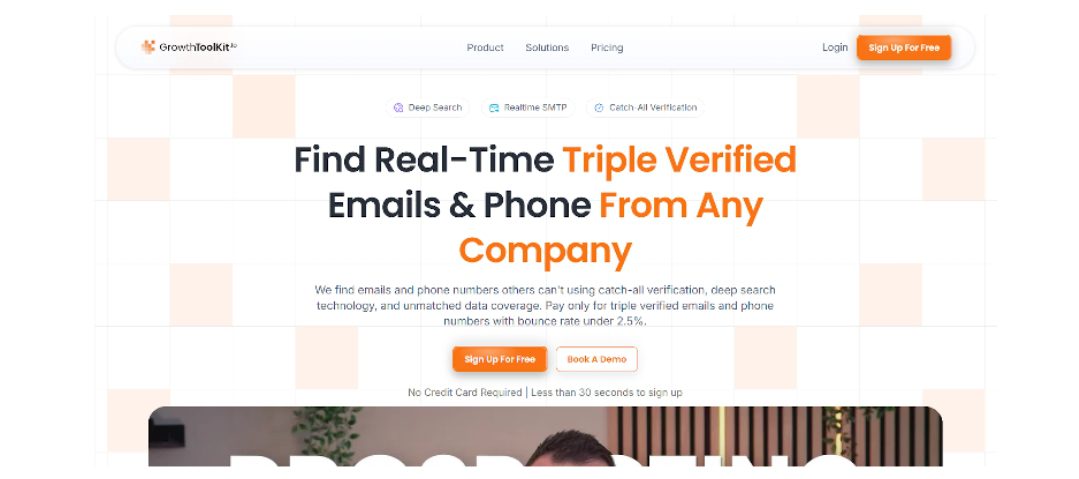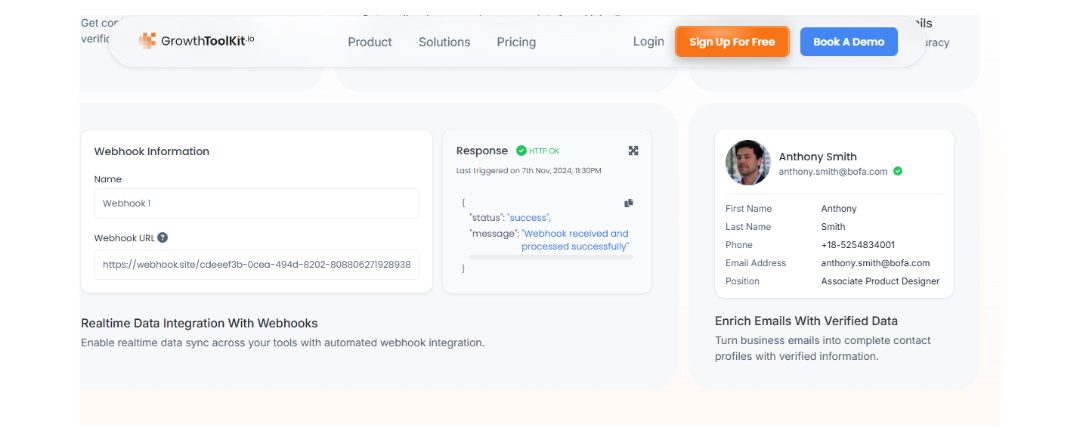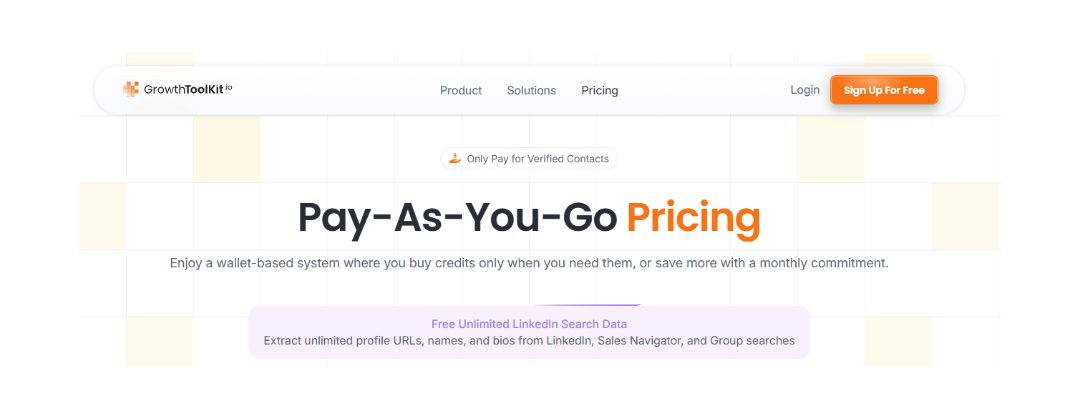A lot of teams are burning budgets on leads that never reply and email lists that fall apart the moment you hit send.
You buy data, you verify it, you pray and you still end up with bounces and bad fits.
Youtube Video:
How To Build An Email List From Scratch
The problem isn’t you. It’s the old way of doing B2B prospecting.
Marketers aren’t willing to accept 15–20% bounce rates anymore, and they shouldn’t. Teams want cleaner data, faster verification, and tools that actually plug into what they’re already using.
That’s where GrowthToolkit comes in. It’s not another “spray-and-pray” platform. It’s built on triple-verified data, so you’re actually reaching people, not just email servers.
They’re demanding better data, faster verification, and systems that actually work with their existing workflows.
GrowthToolkit represents a significant change in how we approach lead generation and verification.
This isn’t just another marketing software claiming to solve your prospecting problems.
It’s a lead generation platform built on triple-verified data that provides what we’ve all been looking for: reliable contact information that actually leads to conversions.
The numbers speak for themselves.
Teams using GrowthToolkit report bounce rates below 2.5%, real-time SMTP verification, and the ability to combine multiple point solutions into one unified platform.
In my experience, this level of accuracy isn’t just nice to have, it’s the key to scaling growth efficiently and avoiding wasted marketing budgets on invalid email addresses.
Marketing automation only works when the data it relies on is accurate.
Let me explain why growth-focused teams are making the switch to GrowthToolkit.
Introducing GrowthToolkit: The Solution to B2B Prospecting Challenges

GrowthToolkit represents a fundamental shift in how marketing teams and agencies approach lead generation.
Built from the ground up to address the data quality crisis plaguing B2B prospecting, this platform delivers what the market desperately needs: verified contacts you can actually reach.
It doesn’t just scrape a database and hope. Every contact is triple-checked before it ever touches your CRM.
That means less time chasing ghosts and more time talking to buyers.
It also consolidates the work you’re probably doing with a patchwork of tools: finding contacts, verifying emails, enriching profiles, connecting to your CRM.
One system. Fewer gaps. Fewer logins
Core Technology Behind GrowthToolkit’s Triple-Verified Data
Let me show you exactly how GrowthToolkit’s triple verification system works under the hood, because this is what separates it from traditional lead generation tools.
The verification process happens in three distinct layers:
Layer 1: Syntax and Format Validation
The system first checks email structure against RFC standards, catching obvious errors like missing @ symbols, invalid characters, or malformed domains. This happens instantly and filters out approximately 15-20% of potentially problematic contacts.
Layer 2: Domain and MX Record Verification
Next, GrowthToolkit validates that the email domain exists and has properly configured mail exchange (MX) records. This step confirms the domain can actually receive emails, eliminating another 10-15% of invalid addresses.
Layer 3: Real-Time SMTP Verification
GrowthToolkit connects directly to the recipient’s mail server through real-time SMTP verification, simulating an actual email delivery without sending a message.
The system receives a response code from the server indicating whether the mailbox exists and can accept messages.
This SMTP handshake happens in milliseconds and catches issues that other tools miss:
- Inactive mailboxes that technically exist but don’t accept mail
- Full inboxes that will bounce messages
- Temporary server issues that could cause delivery failures
- Catch-all domains that accept any email address (more on this later)
That three-layer approach is how teams maintain sub-2.5% bounce rates.
Traditional single-layer checks often land you in the 8–15% range, which tanks sender reputation and wastes outreach time.
Advanced Features That Set GrowthToolkit Apart
Beyond verification accuracy, GrowthToolkit’s deep search capabilities solve one of the most frustrating challenges in B2B prospecting: finding contacts that don’t appear in standard databases. Here’s what makes it different from traditional search tools.
Finding the people everyone else misses
Most tools only show you who’s already in their database. GrowthToolkit actively discovers people who just changed roles, joined newly funded startups, or keep a lower public profile.
On enterprise projects, this has surfaced 30–40% more qualified prospects than platforms like Apollo or Lusha.
Making sense of catch-all domains
Catch-all servers accept anything, so basic validators shrug. GrowthToolkit scores these addresses using server behavior, historical delivery, and domain configs so you can prioritize the ones that are actually worth emailing.
Pro tip: When you’re going after enterprise accounts with catch-all domains, start with “High Confidence” contacts. They tend to perform like fully verified addresses.
This dual capability means you’re not just getting verified data; you’re accessing a broader, more complete universe of prospects that your competitors are missing entirely.
Seamless Integration and Unified Platform Benefits
GrowthToolkit is different from traditional lead generation tools because it’s built as a true integration hub rather than another isolated platform in your tech stack.
Native CRM Connectivity That Actually Works
GrowthToolkit connects directly to your existing systems through robust API access and webhook configurations.

I’ve watched teams struggle with clunky CSV imports and manual data transfers for years. This platform eliminates that friction entirely.
The API documentation provides straightforward endpoints for:
- Bi-directional data sync with Salesforce, HubSpot, and Pipedrive
- Real-time lead enrichment triggered by form submissions or new contact creation
- Automated verification workflows that run in the background without manual intervention
- Custom webhook events for specific trigger actions in your sales process
API Documentation and Why it Matters
Pro Tip: Set up webhook notifications for verification status changes. Your sales team receives instant alerts when high-priority leads are verified and ready for outreach.
The Multi-Tool Replacement Strategy
Let me show you exactly how this impacts your budget. Most agencies I work with juggle 4-6 separate subscriptions:
- Email finder tool: $99-199/month
- Verification service: $79-149/month
- Enrichment platform: $199-399/month
- CRM connector: $49-99/month
Total monthly cost: $426-846
GrowthToolkit consolidates these functions into a single platform with pay-as-you-go pricing.
One agency client reduced their tool stack from six platforms to two (GrowthToolkit + CRM), cutting subscription costs by 68% while actually improving data quality.
The unified dashboard means your team learns one interface instead of context-switching between multiple tools throughout their workflow.
Cost-Effective Pricing Model with Real-Time Data Refreshing
GrowthToolkit’s pricing is fundamentally different from traditional lead generation platforms: you only pay for what you actually use.
The pay-as-you-go pricing model eliminates the waste I’ve seen countless marketing teams experience with fixed subscription tiers.
No more paying for 10,000 credits when you only need 3,500 this month, or scrambling to use up credits before they expire.

Your budget flexes with your actual prospecting needs, whether you’re running a targeted campaign for 500 contacts or scaling up to 50,000.
Let me show you exactly how this impacts your bottom line. The average marketing team I work with previously maintained subscriptions to:
- A contact database platform ($200-500/month)
- An email verification tool ($80-150/month)
- A catch-all checker ($50-100/month)
- API access for integrations (additional $100+/month)
That’s $430-750 monthly in fixed costs, regardless of usage. GrowthToolkit consolidates these into a single, usage-based system.
The real-time data refreshing component delivers another critical advantage. Static databases age the moment you download them.
But here, you’re accessing live intelligence that reflects current employment status, active email addresses, and verified phone numbers.
Pro Tip: Track your monthly lead generation costs across all tools for 90 days, then compare against GrowthToolkit’s usage-based pricing. Most agencies I’ve consulted discover 40-60% cost savings while actually improving data quality.
Conclusion
Automated growth isn’t a buzzword anymore. GrowthToolkit delivers three things modern teams need:
- Better data (triple verification, sub-2.5% bounces)
- Smoother operations (one platform, clean integrations)
- Smarter spend (pay-as-you-go that scales up or down)
Your competitors are already automating. They’re protecting sender reputation, reaching more verified contacts, and moving faster with fewer tools.
The real question isn’t whether to automate, it’s whether you can afford not to.
What teams are seeing:
- Fewer manual tasks (verification runs itself)
- Lower CAC through tighter targeting
- Better ROI with verified contacts
- Simpler stacks by replacing 3–5 tools with one
The teams winning here treat data quality as non-negotiable. Every bounce, every outdated contact, every manual import… it all adds up.
This article boils down to this: it removes friction between your team and measurable results. The platform handles the heavy lifting so you can focus on what counts which is turning prospects into customers.
Want a quick next step?
Start with a small segment you’ve struggled to reach. Run it through GrowthToolkit, enable real-time verification, and compare bounce and reply rates against your current flow.
The difference tends to show up fast.





























